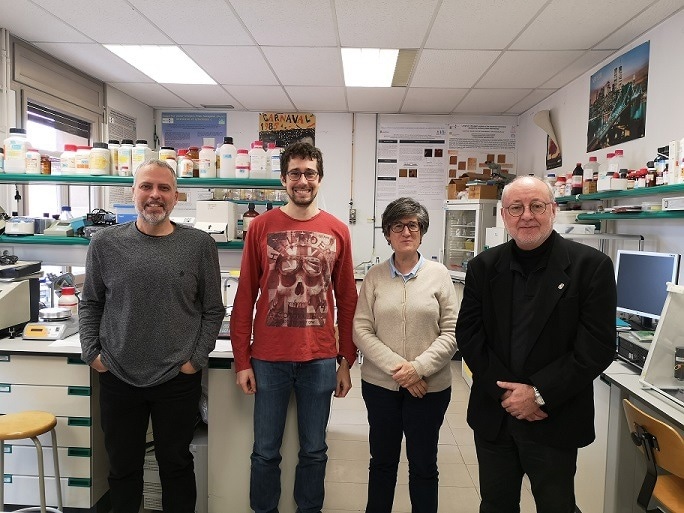The effectiveness of a novel nano molecule as a drug delivery system has been examined in a recent study by the University of Barcelona. The findings, which were reported in the journal Colloids and Surfaces B: Biointerfaces, demonstrate that the anticancer medication that was used as a model can be transported and delivered inside the cells by liposomes created by the researchers.
 From right to left: Òscar Domènech, Adrià Botet, M. Teresa Montero, and Jordi Borrell. Image Credit: University of Barcelona
From right to left: Òscar Domènech, Adrià Botet, M. Teresa Montero, and Jordi Borrell. Image Credit: University of Barcelona
Researchers from the Biology, Physics, Pharmacy, and Food Sciences faculties at UB, as well as those from the Scientific and Technological Centers of the UB (CCiTUB), the Institute of Nanoscience and Nanotechnology of the UB (IN2UB), and the Institute for Bioengineering of Catalonia (IBEC) participated in the study.
Interaction between liposomes and the cell membrane
A liposome is a synthetic spherical vesicle with a membrane composed of two lipid layers, much like the structure of a cell membrane. These molecules have been studied as a model to study cell membranes and as a potential drug delivery system ever since they were discovered in the 1960s.
Understanding how liposomes interact with cell membranes and what fundamental mechanism—adsorption, fusion, endocytosis, or a combination of these three—is involved in the integration of liposomes by cells is one of the challenges of using liposomes as drug delivery vehicles.
The researchers noted, “The interactions between liposomes and the cell membrane can be extremely different depending on the nature of the cell membrane and the lipidic composition of liposomes.”
The university team created tiny lipid spheres called liposomes that are similar in composition to the cell they are trying to treat.
This similarity eases its incorporation and the drug delivery inside the cell.”
Òscar Domènech, Study Member, Institute of Nanoscience and Nanotechnology, University of Barcelona
Study in cell cultures
This research is a follow-up to a previous study by the same research team that examined the fusion mechanisms of liposomes using a streamlined model that mimicked the membrane of HeLa cells, a popular type of culture cells in scientific research.
The researchers stated, “The membrane of HeLa cells is more complex than the model we used in the previous study. Now, we have used real cell cultures in order to obtain a better view of the interaction mechanism of our liposomes.”
The researchers combined two techniques to examine how liposomes interact with cell membranes and gauge how well these nano molecules are incorporated. They employed confocal fluorescence, which enables them to observe fluorescent molecules inside the cell, on the one hand.
To determine whether the nano molecule and its content were entering the cells, the liposomes next contained the fluorescent dye calcein.
However, to observe the physicochemical alterations of the cell surface and measure the stiffness of the cell membrane in the presence of liposomes, the researchers used the atomic force microscopy technique.
The interaction of the researchers’ liposomes confirmed the findings with model membranes and demonstrates the potential of the formulation of these nano molecules as a nano transporter.
Domènech stated, “We show that the lipid composition enables a delivery of the liposome content inside the cell, as well as the effect of the filopodia—small flagella of the cell— in easing the arrival of liposomes at the cell membrane.”
A test with an anticancer drug
The researchers encapsulated methotrexate, an immunosuppressive medication used to treat a number of oncologic, inflammatory, and autoimmune pathologies, to demonstrate the liposomes’ efficacy as a drug delivery system.
Domènech further added, “We could show that our liposomes are ideal for delivering this model molecule, which we know can eliminate cancer cells.”
Future studies with different molecules and cell types are now possible with these findings.
“Our interest would be to extend the methodology to other types of cells or even tissues to show the viability of the analysis, as well as to use other therapeutical molecules encapsulated in liposomes. Moreover—he adds—the two techniques we applied during the study allowed us to obtain results in a fast and minimally invasive way, which in the future could be indicators of the good functioning of a drug against cancer cells,” further added Domènech.
Source:
Journal reference:
Botet-Carreras, A., et al. (2022). On the uptake of cationic liposomes by cells: From changes in elasticity to internalization. Colloids and Surfaces B: Biointerfaces. doi.org/10.1016/j.colsurfb.2022.112968